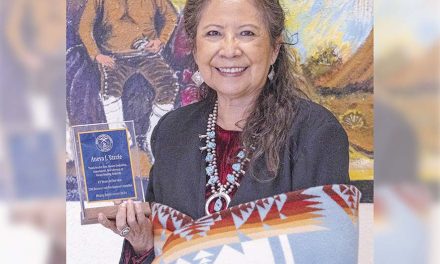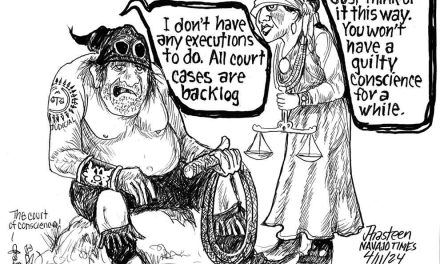
MacRorie comes back to Times
Dick Hardwick, managing editor of the Navajo Times for the past three years, got a step closer to his goal of going back to his old position as the liaison between the BIA and the tribe when the Advisory Committee voted to put Chet MacRorie back in as managing editor.
MacRorie had been editor of the paper for 18 months in 1966 and 1967. He was basically fired by then-chairman Raymond Nakai but officially it was done by the Council, which was under the control of Nakai at that time.
Nakai never trusted MacRorie who he thought was working with those opposed to him to make him look foolish and reduce his chances of being elected. Nakai actually wanted to get rid of MacRorie in early 1967 but couldn’t find anyone with the ability to run the paper and still be supportive of him.
When the Council voted in November 1967 to replace him, there were some who wanted to replace him with a Navajo, feeling if there was any position in the tribe that needed to be run by a Navajo, it was the tribal paper. But the few Navajos whose name came up were rejected because of their anti-administration public statements.
The decision was finally made to turn over the problem to the BIA which agreed to lend out Hardwick to the tribe until a permanent editor could be found.
As for MacRorie, he seemed like a perfect choice. He and new chairman Peter MacDonald got along and when he was terminated in 1967, MacDonald found him a position within the Office of Navajo Economic Opportunity, which he headed at that time.
MacRorie would go on to edit the paper until 1976 when he decided to step down to start an advertising firm with Fran Pawlowki. Their biggest client was the Navajo Times. Paul Natonabah, a photographer at the paper, was named acting editor. A few weeks later, I was selected to replace Natonabah.
The MacRorie years saw massive improvements in the news quality of the newspaper, in part because the tribal council finally gave him $30,000 to hire two reporters. He chose to hire two young Anglos who had experience in working in other newspapers before they worked for the Times.
Probably the best reporter he hired was Jerry Kammer who was working as a teacher at St. Michaels School earning $100 a month. To supplement his income, he started writing free-lance for the Times and MacRorie said later he soon recognized that Kammer had the ability to capture the Navajo sense of thought in all of his features.
Kammer became the go-to reporter on the paper for stories about the Navajo-Hopi land dispute. He probably wrote dozens of land dispute stories, many of them detailing the miseries that Navajo families caught in the middle of the dispute were facing.
He would later write a book on the land dispute, “The Second Long Walk: The Navajo-Hopi Land Dispute,” that is now out of print and hard to find. While at the Times, he also wrote a long article on the attempt by anti-MacDonald forces to hire someone to place a bomb in MacDonald’s car so that when it went off while MacDonald was in his office, it would force the BIA to remove him to prevent future acts of violence on the reservation.
After leaving the Times, Kammer went to work briefly for the Gallup Independent. From there he went to work for the Arizona Republic investigating a number of subjects including the breakdown of the savings and loans companies at that time. That series netted him a number of state and national awards.
In 2002, he left the Republic and joined the Copley News Service, specializing in immigration across the Mexico-United States border. In 2006, he would receive a Pulitzer Prize, the highest honor any reporter can get, for his work on immigration issues.
Hardwick would still remain editor for a couple of more weeks as the entire tribal council would have to approve the appointment.
The Right Rev. Bernard Espelage was laid to rest 50 years ago this week as thousands of Navajo Catholics attended special masses on and off the reservation honoring his more than 20 years as the Bishop of Gallup. He was 79.
He was a member of the Franciscan Order, which had been serving on the reservation for more than 65 years by that time. The order was credited with creating the written Navajo language and for its record-keeping which included, in the early 1900s, an attempt to write down the names of all living Navajos at the time as part of an ancestry project.
Espelage was, by all accounts, greatly beloved by the Navajo people, partly because of the way he treated the Navajo people and partly because of the respect he gave to Navajo traditions.
According to news articles about his death, he opened up a lot of missions on the reservation, resulting in Navajo families being less than 30 miles from a manned Catholic Church or mission.
Using his contacts, he was able to recruit enough priests, some of them Navajo, to oversee these churches and missions. He continued to show respect to the Native culture, allowing Navajo to be spoken at masses.
While not being totally supportive of the Native American Church, he accepted its presence in the reservation, which was far more positive than the attitude of religious leaders for most of the other churches on the reservation.
He would also visit the churches in the reservation on a regular basis and on occasion would oversee the mass himself, something that bishops after him did not do to the extent he did.
After his death, there began a steady decrease in recruitment of new priests forcing many of the Catholic Churches on the reservation to see the number of priests stationed at their church reduced or eliminated altogether.







 Highway 264,
Highway 264, I-40, WB @ Winslow
I-40, WB @ Winslow